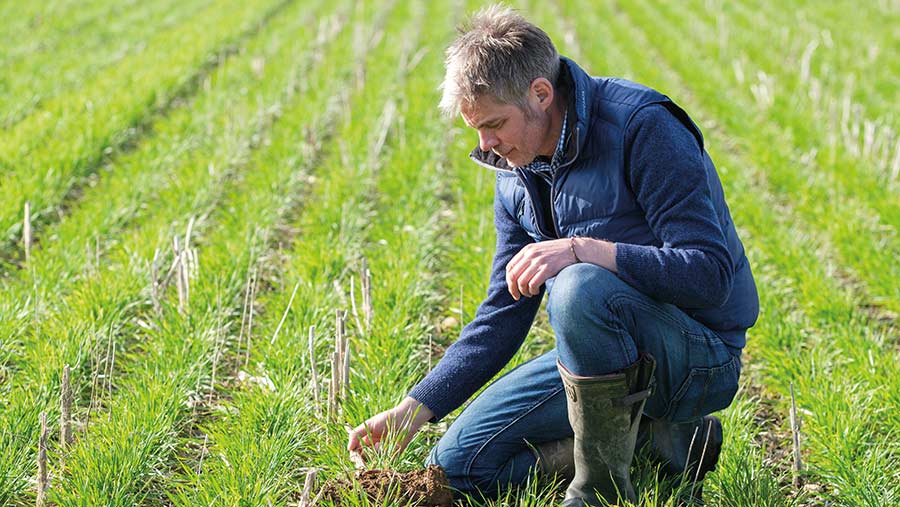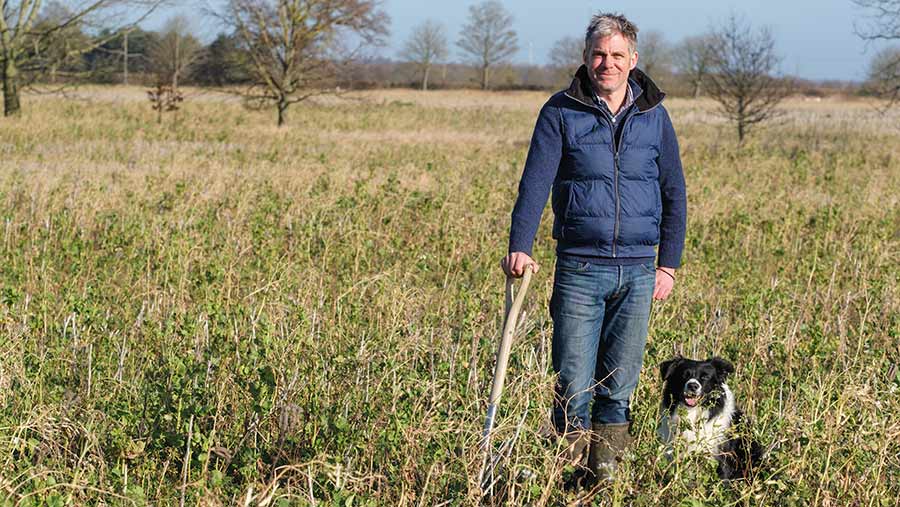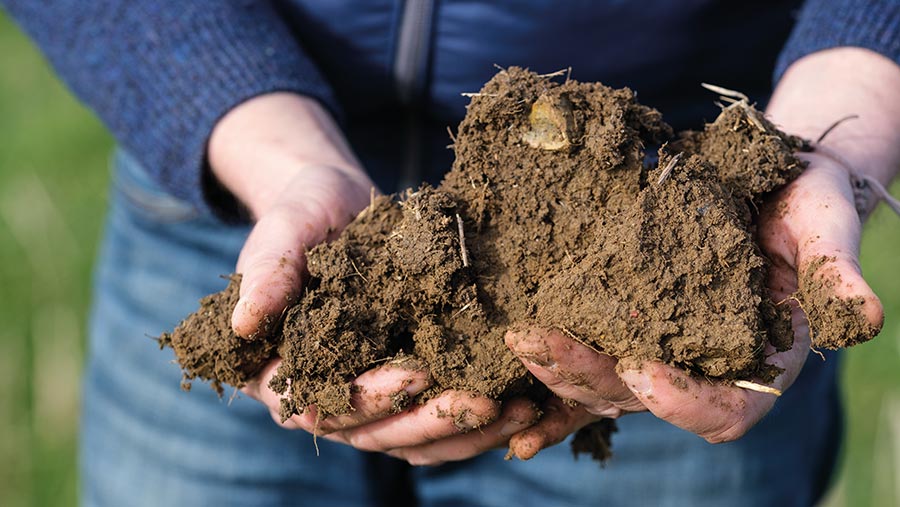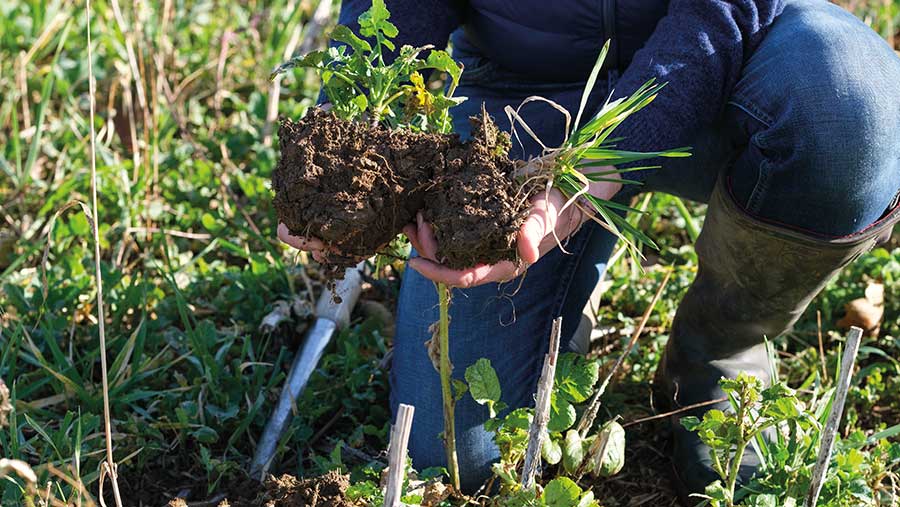How Bedfordshire grower aims to cut N use in milling wheat
 Mike Purnell © Mark Lord Photography
Mike Purnell © Mark Lord Photography Bedfordshire farm manager Mike Purnell has adopted a regenerative approach and achieved big reductions in artificial nitrogen applications on milling wheat.
We find out how his crops have fared.
See also: Video: How to properly set up a fertiliser spreader
Growing 9t/ha crops of Group 1 milling wheat using just 135kg/ha of nitrogen proved to be just beyond the reach of Mike Purnell last year.
In a growing season which threw up several challenges for crops – from a late start to a cold spring and dull summer – he managed to achieve the target yield, but not the quality, with the protein content coming in below par.
While that wasn’t unusual for the year, it highlighted one of the main challenges for milling wheat growers as nitrogen fertiliser use comes under greater scrutiny, both for the sharp rise in its cost and concerns about its carbon footprint.
Undeterred by the 2021 results, Mr Purnell will continue with his plans to reduce all artificial inputs and improve the resilience of the Whitbread Farms system that he oversees, using the lessons learned since making the switch to regenerative agriculture more than six years ago.
Farm facts: Whitbread Farms

Mike Purnell © Mark Lord Photography
- 1,000ha combinable crops
- Eight-year rotation
- 80ha parkland
- 200ha agri-environment schemes
- British White suckler herd
Nitrogen reductions
“We’ve been working to hammer down our nitrogen use for a while,” he says. “By improving our soils, extending the rotation and trying to grow some of our own nitrogen, we’ve made some good progress.
“Now we are looking at how to use nitrogen more efficiently, as well as where we can make further cuts. The aim is for the same yield and quality, but for a lower cost.”
Fertiliser use across the board has fallen, as he takes a systems approach to reducing inputs.
“Nitrogen use averaged 270kg/ha across a limited rotation in 2014 – last year we averaged 150kg/ha and there is still room to improve.
“This is against a backdrop of a substantial rise in the whole-farm gross margin and carbon-negative food production.”
Whatever the product, any environmental impact is taken into consideration before application, with alternatives being investigated.

© Mark Lord Photography
With 450ha of winter wheat in the ground for 2022 harvest, most of which is the Group 1 variety Crusoe due to its better nitrogen efficiency, Mr Purnell’s efforts since he arrived at the estate mean the soil biology is back in balance and working well.
Getting as much organic matter into the soils as possible has been standard practice, as has the use of multi-species cover crops, minimal soil disturbance and clovers.
Rotational diversity
An eight-year rotation, which includes legumes and grass, also helps to manage nitrogen supply and ensures that living roots are making nutrients available to the growing crop.
While its backbone is milling wheat, some 30-40% of the rotation is spring cropping and about 40% is in broad-leaved crops, with diversity playing an important role in reducing nitrogen use.
A key action has been to restore the C:N ratio essential for soil bacteria to thrive and function, as he makes good use of chopped straw as well as chicken muck and sewage sludge ahead of autumn drilling.
That may have to change, he accepts, as he works out what the implications of the Environment Agency’s Farming Rules for Water will have on his system.
“It’s making life more complicated,” he says. “It’s not very practical to apply some of these materials in the spring.”
Clover mulch
Mr Purnell has also experimented with a white clover mulch, with the aim of developing an understorey in the wheat that will supply nitrogen to the crop and help with weed suppression.
“To date, the challenge has been making it survive into the second year,” he reports.
This year, he is looking at whether crimson clover, which is an annual species, can help. He has 20ha of winter wheat with crimson clover growing in it, as well as 10ha of winter beans.
“We blasted the crimson clover over it with a slug pelleter,” he recalls. “The idea is that the crimson clover will release nitrogen as it dies off naturally.
“Whether that’s too late to benefit the wheat remains to be seen, but if not it will be there for the following crop.”
Nitrogen-reducing products
Otherwise, two products have been used to help bring nitrogen use down. Tiros, the endophyte-based seed treatment, is used at the start of the season, with the nitrification inhibitor Liqui-Safe having a role later on in the year.
The seed treatment contains two strains of endophytes – one of which helps the crop to fix atmospheric nitrogen, while the other improves its ability to access other nutrients.
The endophytes colonise the plant and form associations with it, claims manufacturer Unium, maintaining its nutritional balance and keeping it healthy.

© Mark Lord Photography
Liqui-Safe, a urease and nitrification inhibitor for liquid fertiliser from Agrii, allows all the nitrogen to be put on in one application, as it keeps the nutrient where it is needed for longer, offering environmental benefits.
“On our light land, which has a tendency to burn off, it can really help,” says Mr Purnell. “It also means that we aren’t losing it to the atmosphere and minimises any emissions.”
While both products have a cost, reducing nitrogen applications by 20kg/ha means that they pay for themselves, he points out.
Nitrogen use at Whitbread Farms
- Down from an average of 270kg/ha to 150kg/ha in five years
- Tiros seed treatment and Liqui-Safe inhibitor used
- N Tester to fine-tune applications
- Clover mulches being tested
- Soil cores taken in the spring
- Works on a neutral position of 80kg/ha of N
- Applied rates reflect difference between SNS and neutral position
Refining applications
Looking ahead, Mr Purnell has plans for the 2022 season.
He will use Tiros differently and has applied it to all of his home-saved seed, including wheat, barley, oilseed rape and beans, with the intention that it will replace the need for 20kg/ha of nitrogen.
A leaf N Tester will be used to try to refine applications further.
When it comes to nitrogen applications, he is going to put two thirds of the total on early, using Liqui-Safe, in late February or early March, with the remaining third being applied as leaf two emerges.
Trials with foliar nitrogen applications will be undertaken to see how low rates can be pushed.
“As soon as crops have full ground cover, we will use foliar nitrogen in multiple passes. In this way, we will be applying a total of 120kg/ha of nitrogen,” he says.
He is going to have a zero nitrogen plot on the farm as well, so that he can determine the baseline yield.
His one concern about continuing to reduce fertiliser applications is that he might end up mining soil organic matter reserves and reducing inherent soil fertility.
Soil cores are taken in the spring and Mr Purnell works on a “neutral position” of 80kg/ha of nitrogen.
Applied rates then reflect crop removal and the difference between soil nitrogen supply (SNS) results and the neutral position.
“This gives me the confidence to cut what I’m applying without detriment to soil health,” he explains.

